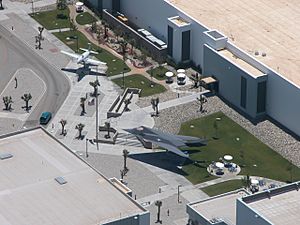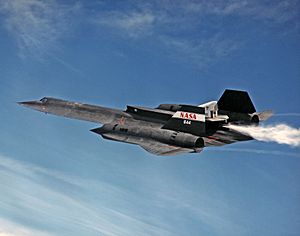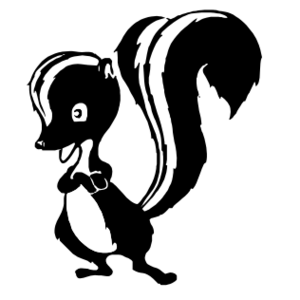Skunk Works facts for kids
Skunk Works is a special team within the company Lockheed Martin. Its official name is Advanced Development Programs (ADP). This team is famous for designing and building some of the world's most advanced and secret aircraft. They work on highly classified projects and create amazing planes that push the limits of technology. Skunk Works has locations in places like Palmdale, California, Fort Worth, Texas, and Marietta, Georgia.
The history of Skunk Works began in 1939 with the Lockheed P-38 Lightning. Later, in 1943, they developed the Lockheed P-80 Shooting Star. Over the years, this team has created many other famous aircraft. These include the Lockheed U-2 spy plane, the super-fast Lockheed SR-71 Blackbird, and the stealthy Lockheed F-117 Nighthawk. They also helped design modern fighter jets like the Lockheed Martin F-22 Raptor and the Lockheed Martin F-35 Lightning II. The F-35 is now used by air forces in many different countries.
The unique name "Skunk Works" came from a funny comic strip called Li'l Abner. In the comic, there was a factory called "Skonk Oil" that made strange things. Because of Lockheed's use of the name, "skunk works" is now a common term. It describes any special group within a company that works on secret or advanced projects. These groups often have a lot of freedom and are not held back by too many rules.
Contents
How Skunk Works Started

There are a few different stories about exactly when Skunk Works began. Engineer Ben Rich said it started in June 1943 in Burbank, California. Another important engineer, Kelly Johnson, sometimes agreed with Rich. Other times, he said it started earlier, in 1939.
The official story from Lockheed says that the U.S. Army Air Force needed a new jet fighter in 1943. Germany was developing jet planes, so the U.S. needed one too. Lockheed was chosen because they had shown interest in jet development before. Just one month after meeting with the Air Force, Kelly Johnson and his team presented their idea for the XP-80. Two days later, Lockheed got the green light to start building it. This is when Skunk Works officially began, with Kelly Johnson leading the way.
The official contract for the XP-80 didn't arrive until October 16, 1943. This was about four months after the work had already started! This became a common way of working at Skunk Works. Often, a customer would ask for something, and the team would start working right away, even before any official papers were signed. Kelly Johnson and his team designed and built the XP-80 in just 143 days. This was even faster than they were asked to do.
A historian named Warren M. Bodie, who also worked at Skunk Works, said that this independent way of working started even earlier. In 1938, Lockheed was asked to build a fast, high-flying fighter plane. This plane would compete with German aircraft. While most of Lockheed was busy building other planes, a small group of engineers worked secretly. They were building the first P-38 Lightning. Kelly Johnson kept them separate from the rest of the factory. They worked in a special walled-off area. They added advanced features to the P-38, like a smooth, flush-riveted aluminum skin. This made the plane faster and stronger.
Because of this special design, the XP-38 was the first fighter plane in the world to fly over 400 miles per hour. The P-38 team even worked for a while in an old bourbon distillery. It smelled very strong! Later, they moved to a bigger building. The smell from a nearby plastic factory was so bad that one engineer, Irv Culver, started answering the phone by saying, "Skonk Works, inside man Culver speaking!"
The name "Skonk Works" came from Al Capp's comic strip Li'l Abner. In the comic, "Big Barnsmell's Skonk Works" was a smelly factory where strange ingredients were brewed. When the name "Skonk Works" became known at Lockheed, the company changed it to "Skunk Works." This was to avoid any legal problems with the comic strip's creators. The name quickly spread and became a common nickname for secret research and development teams. Today, "Skunk Works" is a registered trademark of Lockheed Martin.
In November 1941, Kelly Johnson and the P-38 team started working on a way to add extra fuel tanks to the fighter. This would allow the plane to fly much farther. They did this research without a contract. When the Air Force officially asked for a solution, it was already ready.
Mary G. Ross, the first female Native American engineer, joined Lockheed in 1942. She worked on the math for high-speed flight, which was a new challenge with the P-38. In 1952, she was invited to join the special Skunk Works team.
From the 1950s to the 1990s
In 1955, Skunk Works received a contract from the CIA to build a spy plane called the Lockheed U-2. The goal was to fly over the Soviet Union and take pictures of important sites. The U-2 was tested at a secret base called Area 51 in the Nevada desert. The first spy flight happened on July 4, 1956. The U-2 flights over the Soviet Union stopped after Francis Gary Powers was shot down in his U-2 on May 1, 1960.
Skunk Works had already predicted that the U-2 would not be able to fly over the Soviet Union forever. So, in late 1959, they got a contract to build five A-12 Oxcart aircraft. These planes were designed to fly incredibly fast, over Mach 3.0 (three times the speed of sound). Building such a fast plane out of titanium was very difficult. The first A-12 flight didn't happen until 1962. Later, the U.S. Air Force became interested in the design. They ordered the SR-71 Blackbird, which was a two-seater version of the A-12. This aircraft first flew in 1966 and was used until 1998.
The Lockheed D-21 drone was also built by Skunk Works. It looked similar to the Blackbird. This drone was designed to fly over a nuclear test site in China. It was launched from the back of a special A-12 plane called the M-21. After a crash, the drones were changed to D-21Bs and launched from B-52 bombers with a rocket. Four missions were flown over China, but the cameras were never successfully recovered. Kelly Johnson led Skunk Works until 1975. After him, Ben Rich took over.
In 1976, Skunk Works started building two planes to test stealth technology. These planes were called Have Blue. They were built in just 18 months and were a huge step forward in aviation. They were designed to be very hard for radar to detect. After successful test flights starting in 1977, the Air Force gave Skunk Works the contract to build the F-117 stealth fighter on November 1, 1978.
During the Cold War, Skunk Works was located in Burbank, California. After 1989, Lockheed moved Skunk Works to U.S. Air Force Plant 42 in Palmdale, California. It is still there today. Many of the old Skunk Works buildings in Burbank were torn down in the late 1990s. In 2009, Skunk Works was honored by being added to the International Air & Space Hall of Fame.
Amazing Projects and Aircraft

Skunk Works continues to work on new and exciting projects. In 2015, they were working on a next-generation U-2 aircraft that could be flown by a pilot or fly by itself. This new U-2 was planned to be more of a tactical reconnaissance (short-range spying) aircraft.
Aircraft Developed by Skunk Works
- Lockheed P-38 Lightning (unofficial start)
- Lockheed P-80 Shooting Star
- Lockheed XF-90
- Lockheed F-104 Starfighter
- Lockheed U-2
- Lockheed X-26 Frigate
- Lockheed YO-3
- Lockheed A-12
- Lockheed SR-71 Blackbird
- Lockheed D-21
- Lockheed XST (Have Blue) and Lockheed F-117 Nighthawk
- Lockheed YF-22 and Lockheed Martin F-22 Raptor
- Lockheed Martin X-33
- Lockheed Martin X-35 and Lockheed Martin F-35 Lightning II
- Lockheed X-27
- Lockheed Martin Polecat
- Quiet Supersonic Transport
- Lockheed Martin Cormorant
- Lockheed Martin Desert Hawk
- Lockheed Martin RQ-170 Sentinel
- Lockheed Martin X-55
- Lockheed Martin SR-72
- Lockheed Martin X-59 QueSST
Other Projects
- High beta fusion reactor (a type of energy research)
- Sea Shadow (a stealth ship)
Where the Name "Skunk Works" Came From
The name "Skunk Works" comes from a funny comic strip by Al Capp called Li’l Abner. This comic was very popular from the 1930s to the 1950s. In the comic, there was a run-down factory called "Skonk Works." It was in a remote, rural area. The comic said that many people got sick each year from the bad fumes of "skonk oil." This oil was made by grinding dead skunks and old shoes in a still, for some mysterious reason.
In 1939, Lockheed was growing fast. The P-38 project team moved to a newly bought building that used to be a distillery. Even though Lockheed took over, the sour smell of bourbon mash stayed. The first YP-38 plane was built there. Kelly Johnson later said this distillery was the first of five "skunk works" locations for Lockheed.
Later, when Kelly Johnson's team was developing the P-80 Shooting Star, their office was next to a very smelly plastics factory. One day, an engineer jokingly wore a gas mask to work because of the smell. Another engineer, Irv Culver, started calling the secret facility "Skonk Works." This was a joke about both the smell and how secret the project was.
The team had to be very careful, even with phone calls, because the project was so secret. One day, a call for the P-80 project was accidentally sent to Irv Culver's desk. Culver answered the phone in his usual joking way: "Skonk Works, inside man Culver!" The person on the other end was confused. Culver repeated, "Skonk Works!" The name stuck. Culver later said that Kelly Johnson would often "fire" him twice a day for his jokes, but it was never serious.
In the 1960s, the creators of the comic strip asked Lockheed to change the name. So, Lockheed changed the name of their advanced development team to "Skunk Works." Today, "Skunk Works" and the skunk design are registered trademarks of the Lockheed Martin Corporation.
See also
 In Spanish: Skunk Works para niños
In Spanish: Skunk Works para niños
- Advanced Propulsion Physics Laboratory
- Area 51
- Boeing Phantom Works
- Swamp Works




